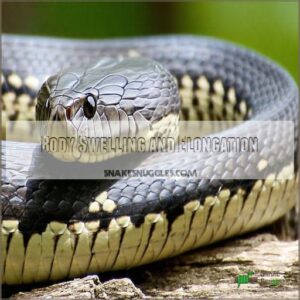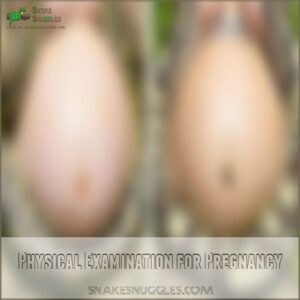This site is supported by our readers. We may earn a commission, at no cost to you, if you purchase through links.

Look for a swollen belly, changes in color, or a snake that suddenly prefers lounging instead of lunching. Pregnancy can also make them a bit moody—think diva-like behavior meets hiding champion.
For a sure answer, consider an ultrasound or X-ray.
Keep in mind, overindulgence in food or underlying health issues might mimic pregnancy’s symptoms.
Curious about a lay-day surprise? Stick around to unravel more about nurturing these legless wonders through their exciting journey!
Table Of Contents
- Key Takeaways
- Determining Snake Pregnancy
- Signs of a Pregnant Snake
- Physical Changes in Pregnant Snakes
- Caring for a Pregnant Snake
- Differentiating Pregnancy From Weight Gain
- Snake Reproduction and Parthenogenesis
- Preparing for a Snake’s Birth or Egg-Laying
- Common Concerns and Considerations
- Maintaining a Healthy Ecosystem Through Breeding
- Frequently Asked Questions (FAQs)
- How do you know if a snake is pregnant?
- How can one know if they are pregnant after having unprotected sex before having their period?
- Can a snake be palpated to confirm pregnancy?
- How long is a snake pregnant?
- How does pregnancy affect a snake’s behavior?
- Do snakes change color during pregnancy?
- How long is a snakes gestation?
- Do all snakes lay eggs?
- Can snakes get pregnant without mating?
- What if my snakes eggs dont hatch?
- Conclusion
Key Takeaways
- Notice a snake’s behavior changes, such as reduced appetite and increased aggression, which can indicate pregnancy.
- Look for physical signs such as a swollen belly and changes in color or posture as potential indicators.
- Use reliable methods like an ultrasound or X-ray for definitive pregnancy confirmation.
- Ensure appropriate care and environmental conditions by maintaining consistent temperature and humidity levels.
Determining Snake Pregnancy
When you’re trying to figure out if your snake is pregnant, it’s all about using the right methods.
ultrasound or X-rays are your best bets for confirmation.
Don’t just rely on behavioral changes or weight gain; these can often mislead even the most experienced reptile enthusiasts.
Reliable Methods for Confirmation
Want to know for sure if your snake’s pregnant? Forget guessing!
Two reliable methods exist: veterinary exams including ultrasound scans and X-ray imaging. These offer definitive confirmation of snake pregnancy, showing you the little ones growing inside.
Blood tests might offer supporting evidence, but imaging is the gold standard.
Don’t rely on just behavioral changes or a swollen pregnant snake belly; get professional help for peace of mind.
Identifying pregnant snakes accurately requires these methods.
Common Misconceptions About Pregnancy
Let’s clear the air about snake pregnancy.
Don’t rely on weight gain alone; it’s a mirage in the desert of snake pregnancy signs. False positives are common.
Determining the sex and compatibility of snakes is also essential, as outlined in a detailed snake breeding guide](https://snakesnuggles.com/snake-breeding-guide/).
Asexual birth—it’s true some females can hold sperm for years or reproduce without mating.
Signs of a Pregnant Snake
Spotting signs of pregnancy in your snake can feel like sleuthing with scales.
Certain behaviors and physical changes, such as reduced appetite or lying on their back, offer clues.
Keep a close eye on their temperament and temperature preferences to better understand their gravid state.
Reduced Appetite or Complete Cessation
Spotting snake pregnancy symptoms isn’t just about guessing.
One big clue is appetite loss. You might notice your snake’s appetite takes a nosedive during gestation.
Stress factors and disease concerns can mimic this pregnant snake behavior, but it’s mostly about the little critter preparing for the big moment.
Keep an eye on these changes as signs of a snake pregnancy.
Changes in Temperature Preference
After a snake’s appetite dwindles, keep an eye on any shifts in how your slithery friend manages their temperature.
Pregnant snakes often adjust their basking behaviors and preferred temperature, seeking warmth for the developing young.
These changes in thermoregulation might mean more heat-seeking or, surprisingly, cooling behavior adjustments. Watch for these patterns in your snake’s behavior as potential pregnancy indicators.
Lying on The Back or Side
A snake lying on its back or side can be as surprising as catching your neighbor sipping your milkshake.
You can find various products related to snakes lying on their sides, such as snake lying on side items, that might provide more insight into their behavior.
This belly exposure, an unusual posture, might signal pregnancy.
Pregnant snakes sometimes adopt this stance for comfort, though it can also indicate stress or illness.
Observe closely, as these snake pregnancy signs provide valuable insights into their behavior changes and overall well-being.
Increased Aggression and Reduced Handling
Noticing your snake getting cranky lately? Increased aggression could signal pregnancy.
Behavioral changes are often linked to stress levels, making handling tricky. A pregnant snake might lash out more, triggered by aggression shifts.
Keep your safety in mind—gentle handling techniques help. Understanding these shifts aids in recognizing pregnancy, ensuring safe interactions amidst these snake behavior changes. Increased aggression could be a sign of pregnancy.
Physical Changes in Pregnant Snakes
You’ll notice some pregnant snakes develop a swollen belly and elongated body, sometimes accompanied by a thickening midsection and subtle color changes.
These physical alterations, along with behavioral shifts, can help you identify a gravid snake.
Though a vet visit is always recommended for confirmation.
Body Swelling and Elongation
You might notice your snake exhibiting body swelling and elongation, key indicators of pregnancy.
The belly size increase isn’t just about extra meals; it’s a sign of little ones on the way.
Think of it like their own personal summer camp full of mystery.
This subtle swelling and girth expansion are classic snake pregnancy symptoms, signaling nature’s magic.
Midsection Thickening and Coloration Changes
Spotting a pregnant snake can feel like finding hidden treasure.
Midsection thickening and color changes signal this exciting journey.
Watch for a swollen belly and intensified coloration—imagine a magic paintbrush at work!
These signs unfold over time, so patience is key.
Notice the snake’s belly size increase and altered color change patterns as it enters this new phase.
Decreased Appetite, Rest, and Warmth Seeking
While your snake might seem more radiant, that’s only half the story.
Watch for gestational weight changes paired with decreased appetite. It’s like they’re conserving energy, skipping meals to nap all day.
This could signal behavioral shifts.
Plus, if they’re seeking extra warmth under their basking lamp, it’s another sign your slithery friend might just be expecting.
Caring for a Pregnant Snake
When caring for a pregnant snake, you’ll need to maintain stable temperature and humidity and provide a cozy nest box for her.
Expect her appetite to dwindle as her due date approaches.
Remember to avoid excessive handling to keep her stress levels low. This is crucial for a pregnant snake’s well-being.
Maintaining Consistent Temperature and Humidity
Think of a pregnant snake’s enclosure as a cozy retreat; maintaining the right temperature and humidity is key.
- Temperature gradients: Make sure there are varied warm and cool areas.
- Humidity control: Use damp substrates or misting.
- Thermostat accuracy: Regularly check and adjust for precise settings.
These help keep your snake comfortable during its gestation period.
Providing a Suitable Nest Box
Crafting the perfect nest box for your pregnant snake is important. Make sure it’s roomy, about twice the snake’s girth, and made from safe materials. Place it in a quiet corner of the enclosure for privacy.
| Nest Box Tips | Details |
|---|---|
| Size | Twice the snake’s girth |
| Material | Non-toxic plastic |
| Location | Quiet and secluded |
| Humidity | Keep moderately high |
| Ventilation | Ensure good airflow |
Getting this right provides comfort during nesting.
Expecting Reduced Appetite and Handling
As your snake’s pregnancy progresses, expect a decrease in appetite—it’s completely normal!
- Dietary adjustments: Reduce feeding frequency.
- Appetite stimulants: Consult a vet if needed.
- Stress reduction: Minimize handling.
- Handling techniques: Gentle, brief interactions only.
- Nutritional needs: Maintain proper hydration.
Gentle handling is key during this sensitive time; pregnant snakes can be more sensitive and even aggressive.
Differentiating Pregnancy From Weight Gain
If your snake starts resembling a stuffed sausage, it could be either pregnant or just indulging in a few too many snacks at feeding time.
Knowing how to differentiate between pregnancy and weight gain in snakes will help you provide the best care, avoiding unnecessary drama about impending parenthood.
Common Causes of Weight Gain in Snakes
Weight gain in snakes isn’t always a sign of pregnancy; understanding the nuances of snake pregnancy weight is essential for responsible reptile care.
Overeating often leads to noticeable belly size increases, while parasites, tumors, or metabolic disorders can also cause swelling.
Fluid retention might be another culprit, mimicking pregnant snake signs.
Keep an eye on your snake’s habits and consult a vet if you notice unusual changes in your snake’s size or behavior.
Physical Examination for Pregnancy
Spotting physical changes is like playing detective with your snake. Pregnant snakes sport a swollen belly and unique weight changes, which can sometimes be confused with weight gain issues that may require snake weight management.
- Belly Swelling: Look for midsection thickening.
- Skin Texture: Check for texture or color changes.
- Posture Shifts: Notice any odd positions.
- Behavioral Shifts: Reduced handling and appetite are clues.
Snake Reproduction and Parthenogenesis
You might be surprised to learn that snakes can reproduce in more ways than you’d expect, including some that don’t involve any social calls with a male snake.
Female snakes have the incredible ability to store sperm for years,
and, in rare situations, they can even become moms through a process called parthenogenesis, which means they skip the whole mating part entirely!
Viviparous and Oviparous Snakes
Snake reproduction fascinates with its viviparous and oviparous pathways.
Imagine the drama: some snakes give live birth, or "viviparous," while others, "oviparous," lay eggs.
Curious about differences? Check out:
| Type | Birth Method |
|---|---|
| Viviparous | Live Young |
| Oviparous | Eggs |
Explore the vibrant reproductive cycles, unraveling gestation variations, clutch size differences, and the snake pregnancy enigma.
Female Snakes Storing Sperm for Years
Imagine a female snake as a time traveler in her quest for motherhood.
With the ability to store sperm for up to six years, she guarantees flexibility in snake reproduction.
This stored sperm can lead to multiple paternity in a single clutch, offering an evolutionary advantage.
Such adaptability impacts on the offspring’s diversity but also on female snake pregnancy and breeding success.
Rare Cases of Parthenogenesis
While rare, parthenogenesis—asexual reproduction—occurs in some snake species.
This fascinating process, bypassing the need for males, raises questions.
Here are four key areas of interest:
- Parthenogenesis mechanisms: How does it work?
- Genetic implications: What’re the long-term effects?
- Environmental triggers: What conditions promote it?
- Evolutionary advantage: Why did it evolve?
Understanding these aspects sheds light on snake reproduction and conservation concerns.
Parthenogenesis in snakes is a truly unique reproductive strategy.
Preparing for a Snake’s Birth or Egg-Laying
To guarantee a smooth birth or egg-laying, you’ll want to prepare a suitable nest box and maintain the right temperature and humidity levels.
Caring for your snake’s eggs or live young requires attention and patience, but with the proper setup, you’ll be ready for this exciting event.
Providing an Adequate Nest Box and Environment
Getting your snake’s nest box just right feels like setting up comfy digs. Aim for a snug size, letting your snake feel safe.
Use soft substrate like shredded paper for comfort, but also consider exploring other reptile substrate options reptile care supplies.
Remember, proper ventilation keeps things fresh.
Toss in a few hiding spots for some nesting privacy. This makes your pregnant snake feel like it’s booked into a five-star hotel.
Controlling Temperature and Humidity Levels
Setting up the ideal environment is key for snake egg development.
Here’s how to manage temperature and humidity:
- Ideal Temperature Ranges: Keep it between 78-84°F using a reptile heat mat.
- Humidity Control Methods: Aim for 50-60% using misting or a humidifier.
- Monitoring Equipment: Use hygrometers and thermometers.
- Ventilation Strategies: Maintain proper airflow without drafts.
Caring for Live Young and Eggs
When caring for live young or eggs, think of yourself as a snake steward.
Keep hatchling nutrition excellent by researching diet needs.
Make certain your incubator setup promotes healthy egg development—it’s like a cozy nursery.
Early handling should be gentle, like leafing through a fragile book, to avoid stress.
Monitor growth and disease prevention like a diligent detective.
Common Concerns and Considerations
When your snake surprises you with an unexpected pregnancy, it’s essential to consult a vet for proper care plans.
Be prepared for issues like egg-binding, which requires immediate attention.
or you’ll have hatchlings needing a crash course in snake parenting.
Unexpected Pregnancies and Veterinary Care
Unexpected pregnancies in snakes can sneak up like a plot twist in your favorite mystery novel.
If your snake suddenly seems larger or exhibits signs of pregnancy, it’s time for emergency care consultation with a vet.
They provide dystocia treatments and essential breeding advice.
Remember, post-partum care is vital for hatchling needs and managing snake pregnancy weight gain.
Stay informed and proactive!
Egg-Binding and Immediate Veterinary Care
So, you’ve dealt with an unexpected pregnancy—now what?
Egg-binding, a serious complication during snake pregnancy, needs immediate vet care. This occurs when eggs get stuck, causing pain and potentially death. Quick action is key; your vet can offer emergency treatment, potentially saving your snake’s life.
Early detection and prevention tips are invaluable for snake health.
Don’t delay; seek help now!
Researching Hatchling Care and Feeding
Diving into hatchling care is like stepping into a whole new world.
Start by checking their hatchling diets: Make certain balanced nutrition suits their growth stages by considering factors like snake breeding health considerations.
Watch for common illnesses like respiratory issues.
Remember to establish proper setup needs for comfort.
Track developmental milestones for healthy growth.
Tailor care for snake neonates moving to juveniles.
A focused plan guarantees thriving snake hatchlings!
Maintaining a Healthy Ecosystem Through Breeding
To maintain a healthy ecosystem, understanding snake reproductive processes helps you create an ideal breeding environment.
By minimizing stress for your snakes, you maximize their reproductive success.
which, let’s face it, is a bit like being a snake midwife.
Understanding Reproductive Processes and Cycles
Understanding snake reproductive cycles is like reading the calendar, but for reptiles. By grasping breeding frequency and mating behavior, you get a handle on snake gestation periods and clutch size factors.
To successfully breed snakes, it’s essential to implement a proper cooling period (https://snakesnuggles.com/snake-breeding-incubation-techniques/), which can last anywhere from 60-90 days depending on the species.
Did you know some female snakes store sperm for years, ready for use when conditions are right? This makes predicting pregnancy a blend of science and mystery! snake reproductive cycles breeding snakes gestation periods store sperm
Providing a Suitable Environment for Breeding
Wondering how to set the stage for breeding snakes? Creating a cozy and suitable environment is key.
- Enclosure Size: Make certain the space is roomy yet secure for comfort.
- Humidity Control: Maintain consistent moisture levels for optimum health.
- Substrate Type: Choose materials that mimic natural habitats.
These tweaks help during the snake breeding season and support successful snake pregnancy care.
Minimizing Stress and Maximizing Success
With a well-prepared breeding habitat, focus on stress reduction to boost success.
Consider habitat enrichment and best nutrition.
Gently handle your snake to keep her calm.
Treat the breeding season like a maternity spa for snakes—think cozy and nourishing. snake pregnancy care
Attention to these details helps in snake pregnancy care, ensuring your gravid friend thrives and births successfully. breeding season
Frequently Asked Questions (FAQs)
How do you know if a snake is pregnant?
Determining snake pregnancy can feel like solving a mystery.
Look for signs like decreased appetite, swollen belly, or nesting behavior.
However, confirming it requires an ultrasound or X-ray.
Handling should be minimal to reduce stress.
How can one know if they are pregnant after having unprotected sex before having their period?
You might notice symptoms like nausea, breast tenderness, or fatigue a week after unprotected sex.
The best way to confirm pregnancy is a home test after your missed period.
Visit a healthcare professional for reliable results.
Can a snake be palpated to confirm pregnancy?
Palpating a snake to check for pregnancy is tricky, especially without training.
Unlike mammals, snakes don’t have easily palpable structures.
Instead, a vet’s ultrasound is the best bet for confirming pregnancy and checking clutch size.
How long is a snake pregnant?
Snake gestation varies widely.
ball pythons incubate eggs for 44-54 days, while boa constrictors carry live young for 5-8 months.
Larger species have longer waits; smaller ones, shorter stints.
Nature’s trick on timing keeps you guessing!
How does pregnancy affect a snake’s behavior?
Pregnancy in snakes might lead to noticeable behavior changes like reduced appetite, increased aggression, or seeking secluded, cooler areas.
You may also observe nesting behavior as they prepare for egg-laying or giving birth.
Do snakes change color during pregnancy?
During pregnancy, some snakes might exhibit a slight color change, but it’s not universal.
You might notice subtle shifts, often in response to hormonal changes.
Always consult a vet for accurate diagnosis if you’re uncertain.
How long is a snakes gestation?
A snake’s gestation varies wildly!
It depends entirely on the species.
For example, ball pythons take 44-54 days, while boa constrictors need 5-8 months.
That’s quite a difference, right? Your vet can help determine the specifics.
Do all snakes lay eggs?
Not every snake lays eggs; some are live-bearing.
Species like boas and vipers give birth to live young, while many others, such as pythons and corn snakes, are egg-layers.
Each has its unique reproductive style.
Can snakes get pregnant without mating?
Snakes can sometimes reproduce without mating through a process called parthenogenesis, though it’s rare.
Certain species like the Brahminy Blind Snake are known for this.
Usually, female snakes store sperm from previous encounters for future reproduction.
What if my snakes eggs dont hatch?
Think of patience as your ally when snake eggs don’t hatch.
Check the temperature and humidity in their enclosure; both are essential for development.
If conditions are right, consult a reptile vet for further guidance and possible solutions.
Conclusion
Think of snake pregnancy like a hidden treasure chest—you’ve got to know the signs to reveal its secrets.
Recognizing if a snake is pregnant involves observing behavioral changes, body swelling, and appetite shifts.
Confirming pregnancy with methods like ultrasound is key.
Watching for these clues guarantees you provide the right care, maintaining the health of both the snake and potential offspring.
So, if you’re baffled by your snake’s behavior, these signs can guide you.


















